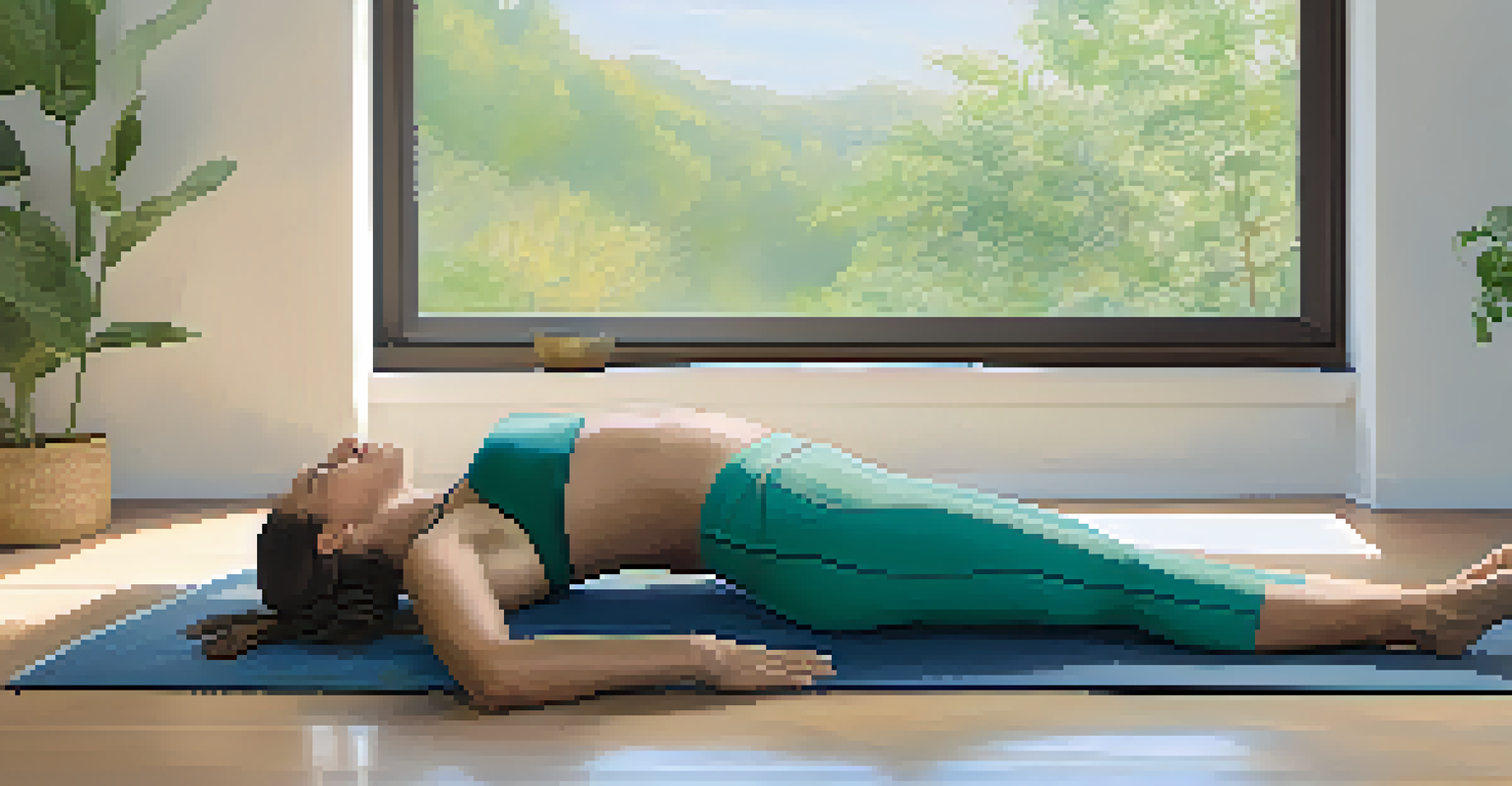Restorative Yoga: A Healing Approach for Chronic Pain

What is Restorative Yoga and How Does It Work?
Restorative yoga is a gentle, nurturing practice designed to relax the body and mind. Unlike more vigorous forms of yoga, restorative yoga uses props like blankets, bolsters, and blocks to support the body in various poses. This supportive approach encourages deep relaxation, allowing the body to release tension and stress.
Yoga is the journey of the self, through the self, to the self.
The primary goal of restorative yoga is to promote healing and recovery. By holding poses for extended periods, practitioners can achieve a meditative state that enhances overall well-being. This practice is particularly beneficial for those dealing with chronic pain, as it helps to calm the nervous system and promotes a sense of safety.
In essence, restorative yoga serves as a sanctuary where individuals can reconnect with their bodies. It's about finding comfort and ease, which is crucial for those suffering from persistent pain. As you delve deeper into this practice, you'll discover how it can serve as a powerful ally in your healing journey.
Understanding Chronic Pain and Its Impact
Chronic pain affects millions of people worldwide and can stem from various conditions, such as arthritis, fibromyalgia, or past injuries. Unlike acute pain, which typically subsides after healing, chronic pain persists and can disrupt daily life. This ongoing discomfort can lead to emotional challenges, including anxiety and depression.

The impact of chronic pain extends beyond physical sensations; it can alter one’s quality of life, affecting relationships, work, and overall happiness. Many individuals find themselves trapped in a cycle where pain leads to inactivity, which in turn exacerbates their discomfort. Understanding this cycle is crucial for finding effective interventions.
Restorative Yoga Eases Chronic Pain
This gentle practice promotes healing by encouraging deep relaxation and reducing stress, which can significantly alleviate pain.
By recognizing the multifaceted nature of chronic pain, we can better appreciate how restorative yoga offers a holistic approach. It provides not only physical relief but also emotional support, allowing individuals to navigate their pain with greater ease and resilience.
Benefits of Restorative Yoga for Chronic Pain Sufferers
Restorative yoga offers a myriad of benefits for those managing chronic pain. One of the key advantages is its ability to reduce stress, which can significantly alleviate pain levels. When the body is in a relaxed state, it can reduce muscle tension and decrease the production of stress hormones, creating a more favorable environment for healing.
The body is your temple. Keep it pure and clean for the soul to reside in.
Additionally, this practice encourages mindfulness, teaching individuals to tune into their bodies and recognize the signals they send. By fostering a greater awareness of physical sensations, practitioners can learn to differentiate between pain and discomfort, leading to more effective pain management strategies. This shift in perspective can be empowering for those who feel overwhelmed by their pain.
Moreover, restorative yoga enhances flexibility and circulation, which are vital for overall health. As participants gently stretch and breathe into their bodies, they can improve blood flow and promote healing in affected areas. This combination of physical and mental benefits makes restorative yoga a valuable tool for anyone dealing with chronic pain.
Key Poses in Restorative Yoga for Pain Relief
Several restorative yoga poses are particularly beneficial for alleviating chronic pain. One such pose is Supta Baddha Konasana, or Bound Angle Pose, which opens the hips and promotes relaxation. By lying back on a bolster and allowing the knees to fall open, you can release tension in the lower body while calming the mind.
Another effective pose is Viparita Karani, or Legs-Up-The-Wall Pose. This gentle inversion can help reduce swelling in the legs, improve circulation, and promote a sense of calm. It's an excellent position to hold for several minutes, allowing the body to recharge.
Mindfulness Enhances Pain Management
Incorporating mindfulness into restorative yoga helps individuals develop a deeper connection with their bodies, fostering acceptance and compassion towards their pain.
Lastly, Child's Pose is a favorite among many for its soothing effects. By kneeling and resting the torso on the thighs, you can create a sense of safety and comfort. It encourages deep breathing and helps to release tension in the back, making it a perfect addition to any restorative yoga practice.
Creating a Restorative Yoga Space at Home
Setting up a restorative yoga space at home can enhance your practice significantly. Find a quiet area where you can create a serene atmosphere, free from distractions. Soft lighting, calming scents like lavender, and a comfortable temperature can all contribute to a peaceful environment.
Gather the necessary props, such as bolsters, blankets, and straps. These items will support your body during poses, allowing you to focus on relaxation rather than effort. If you don’t have traditional yoga props, household items like pillows and cushions can work just as well.
Lastly, consider incorporating soothing music or guided meditations to deepen your experience. This ambiance can help signal to your body that it’s time to unwind and heal. Creating this space will make your restorative yoga practice more inviting and effective.
Incorporating Mindfulness into Your Practice
Mindfulness is an essential component of restorative yoga. It encourages practitioners to be present in the moment, acknowledging their thoughts and feelings without judgment. This practice of mindfulness can be particularly beneficial for those dealing with chronic pain, as it helps to cultivate a sense of acceptance and compassion toward oneself.
As you settle into a pose, focus on your breath and the sensations within your body. Notice any areas of tension or discomfort, and allow yourself to breathe into those spaces. This gentle awareness can help you develop a more profound connection with your body and its needs, ultimately aiding in pain relief.
Create a Serene Yoga Space at Home
Establishing a calming environment with props and soothing elements can enhance your restorative yoga practice and support relaxation.
Incorporating mindfulness can transform your yoga practice from a physical activity into a holistic experience. It encourages you to listen to your body and honor its capabilities, which can be incredibly empowering. Over time, this awareness may lead to improved pain management and a greater sense of peace.
Getting Started with Restorative Yoga
If you're new to restorative yoga, starting slowly is key. Consider joining a class led by an experienced instructor who can guide you through the poses and help you understand the principles of the practice. Many studios now offer specialized classes tailored for those dealing with chronic pain.
Alternatively, you can explore online resources, such as videos or apps, that offer restorative yoga sequences. Look for sessions that emphasize gentle movements and relaxation techniques, ensuring they align with your needs. As always, listen to your body and modify poses as necessary.

Remember, the journey to healing is personal and unique. Allow yourself the grace to explore what works best for you, and don't hesitate to seek support from trained professionals. With patience and practice, restorative yoga can become a vital part of your pain management toolkit.